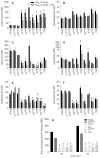Chloroquine resistance in Plasmodium falciparum malaria parasites conferred by pfcrt mutations
- PMID: 12364805
- PMCID: PMC2954758
- DOI: 10.1126/science.1074045
Chloroquine resistance in Plasmodium falciparum malaria parasites conferred by pfcrt mutations
Abstract
Plasmodium falciparum chloroquine resistance is a major cause of worldwide increases in malaria mortality and morbidity. Recent laboratory and clinical studies have associated chloroquine resistance with point mutations in the gene pfcrt. However, direct proof of a causal relationship has remained elusive and most models have posited a multigenic basis of resistance. Here, we provide conclusive evidence that mutant haplotypes of the pfcrt gene product of Asian, African, or South American origin confer chloroquine resistance with characteristic verapamil reversibility and reduced chloroquine accumulation. pfcrt mutations increased susceptibility to artemisinin and quinine and minimally affected amodiaquine activity; hence, these antimalarials warrant further investigation as agents to control chloroquine-resistant falciparum malaria.
Figures

Comment in
-
Parasitology. A requiem for chloroquine.Science. 2002 Oct 4;298(5591):74-5. doi: 10.1126/science.1077573. Science. 2002. PMID: 12364772 No abstract available.
References
-
- Ridley RG. Nature. 2002;415:686. - PubMed
-
- Sullivan DJ, Jr, Matile H, Ridley RG, Goldberg DE. J Biol Chem. 1998;273:31103. - PubMed
-
- Pagola S, Stephens PW, Bohle DS, Kosar AD, Madsen SK. Nature. 2000;404:307. - PubMed
-
- Ginsburg H, Ward SA, Bray PG. Parasitol Today. 1999;15:357. - PubMed
-
- Wellems TE, et al. Nature. 1990;345:253. - PubMed
Publication types
MeSH terms
Substances
Grants and funding
LinkOut - more resources
Full Text Sources
Other Literature Sources

